How to Grow Your Own Bouquet
- horticulturist and gardening expertMay 27, 2023
Add a few garden fresh flowers to vases in your home to make every day and gathering special. Just fill a few spaces, garden beds, and containers with easy-care flowers to cut and enjoy in bouquets and arrangements all season long. Growing plants that can double as cut flowers makes it easy to create casual, fresh-cut bouquets for your dinner table, guest room, special occasions, or to share with family and friends.
Growing Your Own Flowers for Your Bouquet
Select a variety of flowers that bloom all season long. Spring and summer flowering bulbs and perennials provide variety throughout the season. Include annual flowers for season-long bloom and extended vase life.
When creating a cutting garden, look for ways to maximize productivity with minimal maintenance. Select varieties that will look great together in a vase and with the other flowers you are already growing in the garden. If space is limited, consider choosing a color palette and growing flowers that complement these colors. Narrowing the choices this way may make it easier to maximize combination possibilities.
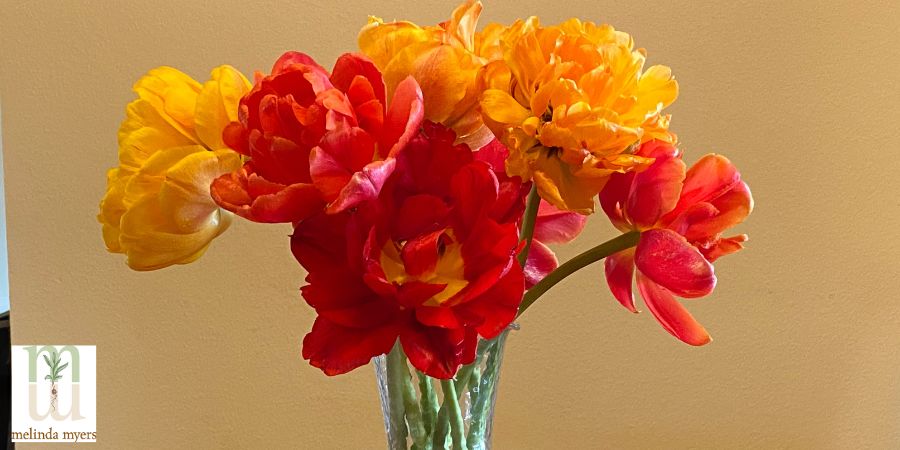
Tulip Bouquet
As with any garden, proper soil preparation means healthier plants and more flowers to enjoy and harvest. Adding flowers for cutting to thriving garden beds, including your vegetable garden, is one way to get started. Improve soil as needed by incorporating several inches of compost into the top 8 to 12 inches of soil or employ no-dig methods.
Include Milorganite in your soil preparation. This low nitrogen slow-release fertilizer encourages balanced above- and below-ground growth and won’t interfere with flowering. As microorganisms work on releasing the nutrients from the Milorganite, some of the phosphorous and potassium bound to the soil is made available for the plants to use. This phosphorous and the non-leaching phosphorous in Milorganite promote flowering and root development. Plus its slow-release formulation won’t damage the plants when the weather turns hot and dry. Make a second application in 6 to 8 weeks if needed.
Make sure your plants receive sufficient water throughout the growing season. Always water thoroughly to promote a robust root system that is able to absorb water from a larger area. Mulch the soil with shredded leaves, evergreen needles, or other organic matter. This conserves moisture so you need to water less often, suppresses weeds, and as the mulch decomposes it improves the soil.
Harvesting and Conditioning Bouquet Flowers
Gather your flowers in the morning after the dew has dried whenever possible. The temperatures are cool, and the plants are hydrated. The evening is the next best time. But we all have those moments when we need a last-minute arrangement for dinner. I have been known to harvest flowers right before guests arrive or when picking my vegetables for the evening meal. They may not last as long, but we were able to enjoy them for that dinner or special event and a few more days.
Use a pair of sharp snips or bypass pruners to make the cut above a set of healthy leaves or back to an adjoining branch. Keep in mind the more flowers you harvest, the more flowers produced on annuals and some of your perennial plants.
Remove the lower leaves and immediately place the flowers in a bucket of water. I always take a bucket of water to the garden to keep the flowers fresh and hydrated while harvesting. Let the flowers stand in a cool place, out of direct sunlight, in tepid water for several hours or, better yet, overnight.
Recut the stems on a 45º angle when making arrangements. This prevents them from sitting flat on the bottom of the vase and exposes more of the surface area to the water. Remove any additional foliage as needed. Leaves submerged in water tend to turn slimy and increase the risk of bacterial growth which decreases the life of your cut flowers.
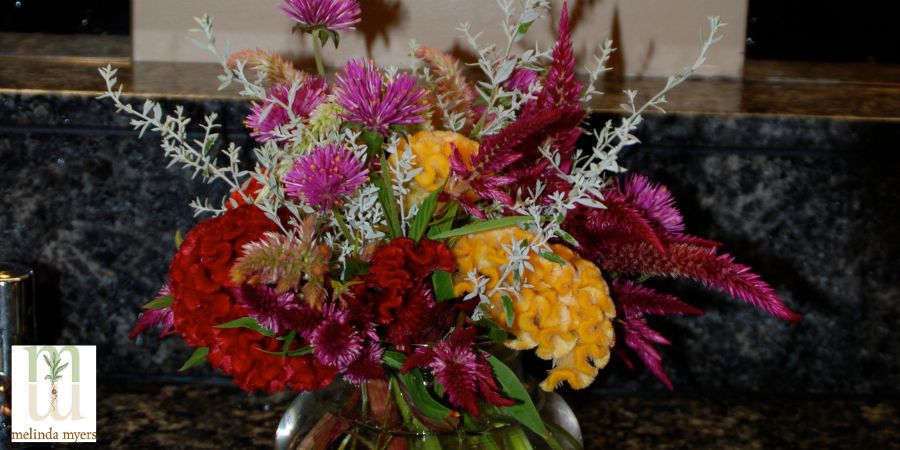
Bouquet of Celosia, Artemisia and Globe Amarath
Always use a clean vase and fresh water to maximize your cut flowers’ vase life. Add a floral preservative to the water to further extend their longevity. Check the water level often, making sure the cut ends are always covered with water
Change the water often to keep your flowers looking their best for as long as possible. Debra Prinzing of Slow Flowers https://www.slowflowers.com recommends securing the arrangement before placing it in the vase. This makes it easier to lift and recut the stems as needed when changing the water.
Since different flowers last in an arrangement for different lengths of time, I am continually reworking my arrangements, removing flowers as they fade until just one or two types remain. This keeps it interesting and extends my enjoyment.
Budget Bouquets
It can be cheaper to grow your own bouquet. Start by looking at what is already growing in your gardens. Spring flowering bulbs, cool weather annuals like pansies and snapdragons, and branches pruned from quince, crabapples, pussy willows, forsythia, and other spring flowering trees and shrubs make great spring arrangements.
Maximize your enjoyment when adding these to your arrangements. Place the tree and shrub branches in cool water, about 60°F, in a brightly lit location until ready to use. Make a ½ to 1” long cut up the middle of the bottom of the stem for better water uptake before adding them to the arrangement.
Lilacs are a favorite but can be a source of frustration when using them in an arrangement. Try placing them immediately in water while still in the garden. Once inside, remove the leaves, recut the stems, and place them in a bucket of cool water for at least an hour. Cut the stem vertically 1-2” from the bottom and twist. Place in cool dark place for 1- 2 hours before arranging.
Harvest daffodils when the buds show color and are perpendicular to the stem. Since they exude sap that blocks water uptake in other flowers, you need to either arrange them in their own vase or prepare them before adding them to an arrangement, just cut the stems to the desired length and soak them for one to four hours in their own vase before adding them to the arrangement.
Tulips continue to grow in the vase so plan for this as you make your arrangements. Extend your enjoyment by harvesting when the flowers are showing about 50 to 75% of their color. If you are tired of their droopy stems, dry this technique. Recut the stems, wrap the stems in newspaper or brown craft paper, and set in several inches of water for 12 to 18 hours.
Peonies are a favorite in the spring garden and arrangements. Harvest these when the buds begin to show some color and are soft like a marshmallow. The flowers will open soon and last for five to ten days.
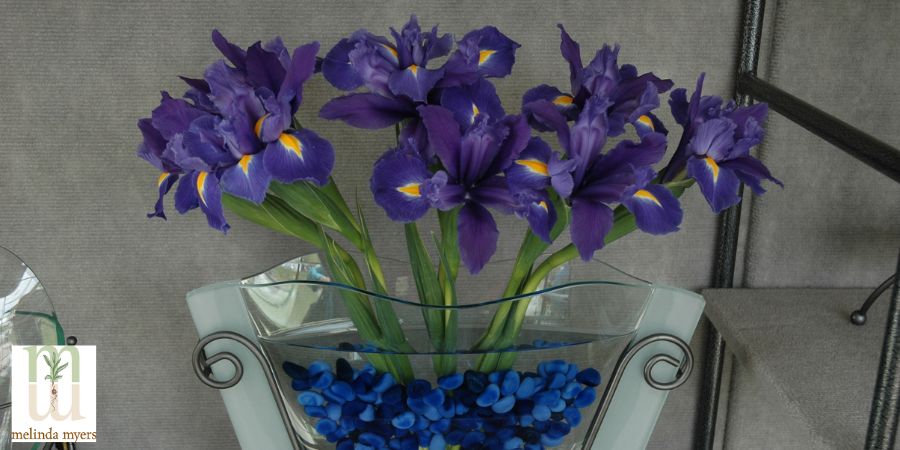
Bouquet of Irises
Don’t overlook other spring flowers like columbine, bleeding heart, Siberian and bearded iris, and more. A friend and I used a lady’s mantle in her daughter’s wedding arrangements. The chartreuse flowers and unique foliage made a great filler.
Summer brings lots of choices for most gardeners but plan on adding a few annuals for additional color in the garden and bouquets. Stretch your budget by buying flats of plants and sharing the plants and cost with friends. You’ll each spend less per plant when buying in bulk.
Consider starting some of your plants from seeds. Many like zinnias and marigolds, can be planted directly in the garden and are ready to start harvesting in about eight weeks. Just harvest these when the flowers are fully open for the best and longest display.
Sunflowers are a favorite and some of the newer varieties like Sunfinity, flower throughout the growing season. The All-America Selections winner Concert Bell sunflower produces 10 to 12 flowers on each upright stem. All you need is one or two stems to create an impressive arrangement.
Start cosmos from seeds indoors four to six weeks before the last spring frost or directly in the garden. The fine foliage adds texture to the garden and the white, pink, and lavender blooms light up the mid-summer through fall garden. Plant tall varieties en mass to eliminate the need for staking. Or grow shorter varieties like Sonata and Cosmic.
Regularly check your perennial gardens and shrub borders for flowers and foliage to combine with annuals in your arrangements. Coral bells are best harvested when 70% of the flowers are open. Salvias, lavender, and Liatris provide vertical accents, while the round flowers of rudbeckia, coneflower, Shasta daisies, and phlox serve as a focal point. Harvest phlox when the flowers are fully open.
Roses, hypericum, elderberry, rose-of-Sharon, and dogwoods are just a few to consider. Hydrangeas are a popular group of shrubs, and the flowers can be added to your summer and fall arrangements. Extend their vase life by soaking flowers, head down, in cold water for 1 hour. Allow it to drip dry, then recut the stem and place it in warm water overnight. Or dip the cut end in alum before placing in the vase.
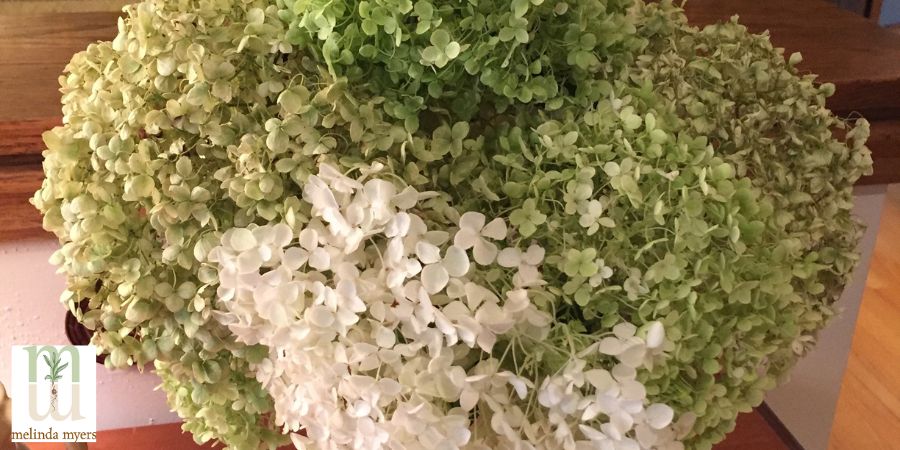
Bouquet of Hydrangeas
Ornamental grasses’ flowers, foliage, and seed heads make excellent additions. Look to houseplants and shrubs for more foliage options. Papyrus, New Zealand flax cannas, prayer plant, and monster are just a few to try. Herbs like Rosemary, fennel, dill, sage, borage, and lavender add fragrance as well. Clip a branch or two from Ninebark, boxwood, viburnum, pines, spruce, juniper, yews, or arborvitaes to add greenery and texture to your arrangements.
As you can see the possibilities for creating cut flower arrangements are endless. Don’t be afraid to try something new and different. The worst that can happen is the flower fades quickly, but your experiment may reward great benefits. You’ll find more tips on extending the vase life of cut flowers on the internet and from fellow gardeners and florists.
Growing and Arranging Your Own Wedding Flowers
Many gardeners take this one step further to save money and add a personal touch to their wedding day with homegrown cut flowers. Many enlist family and friends or take on the task themselves. In either case, allow the needed time and be flexible.
I have been that friend that helped others create their own special bouquets and arrangements. My experience working at a plant store early in my career provided floral design experience and insight to help with their plans. Several friends wanted potted plants for the guests' dinner tables, a few wanted to harvest whatever was flowering from their, friends and family’s gardens, and one or two allowed me to buy flowers from the florist. All presented opportunities to try new things but also made me a bit nervous making sure we had enough of what the bride desired.
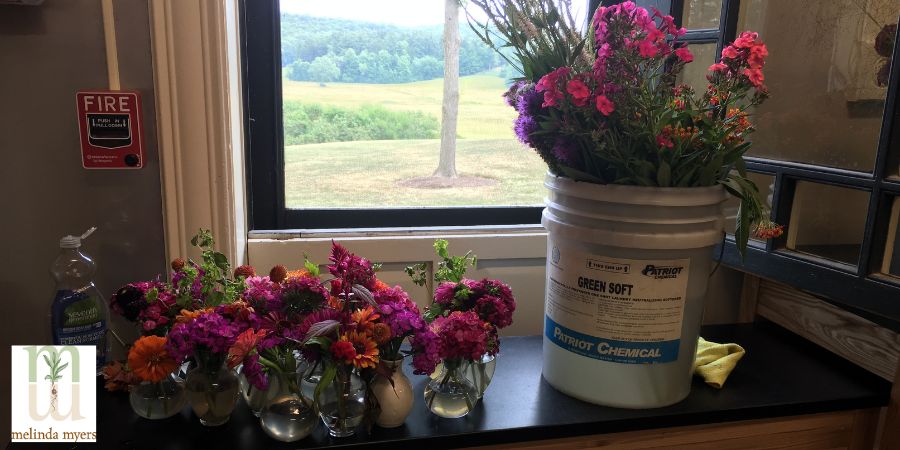
Arranging Your Own Bouquets
If you are planning to grow your own wedding flowers, be flexible with your choices and plan for unexpected challenges. Weather can vary every growing season, affecting the quality and availability of flowers in the garden. Hot weather means flowers mature faster and don’t last as long. Cooler temperatures delay bloom.
Hail, heavy rains, insects, disease and hungry critters can destroy your plants in short order. If possible, ask several friends to grow some of the flowers you plan to use. This increases the odds you’ll have plenty of flowers for your bouquets and arrangements. Consider buying a few things from the florist to fill in as needed. I always invested in a few flowers just in case. Sometimes we needed them, and other times we made extra bouquets to give to special friends and family members.
Allow time to gather and prepare the bouquets and arrangements a day or two before the wedding. The fresher the flowers the better they will look on your wedding day. I have spent many sleepless nights before a wedding when creating arrangements and bouquets for friends. Enlist the help of others to share the workload, reduce stress and increase the fun.
Harvest garden-fresh flowers at their peak and condition them before crafting them into bouquets or arrangements. Remove the leaves off the flower stems of those used for bouquets. Just remove the bottom few leaves that would be submerged in water for those displayed in vases. Cut the bottom of the stem at a 45-degree angle and set in a bucket of water to keep them fresh while arranging.
Start bouquets with a base of finer flowers that provide unity in the arrangement. Next, add a few larger blooms for a focal point. Fill in voids and add more color with greenery and more small flowers. Secure the stems with a rubber band, cut them to the desired length, and wrap with ribbon. Allow bare stems to show below the ribbon for a more casual look, or cover the stems with ribbon for more formal ceremonies.
Use a similar strategy when arranging flowers in a vase. Don’t be afraid to adjust your design as you go. The best part of creating your own wedding flowers is the unique and personal twist only you can provide.
Cutting and arranging flowers is a fun way to exercise your creativity and bring the beauty of your garden indoors. Don’t worry if the selection of flowers is limited in your garden. Strike up a trade with fellow gardeners. Each of you can share what’s blooming in your landscape throughout the growing season. Then plan on adding some more annuals, bulbs, and perennials to your landscape in the future. The more you do it, the easier it gets, and you’ll soon be sharing your flowers with friends, neighbors, family, coworkers, and everyone who stops by.

